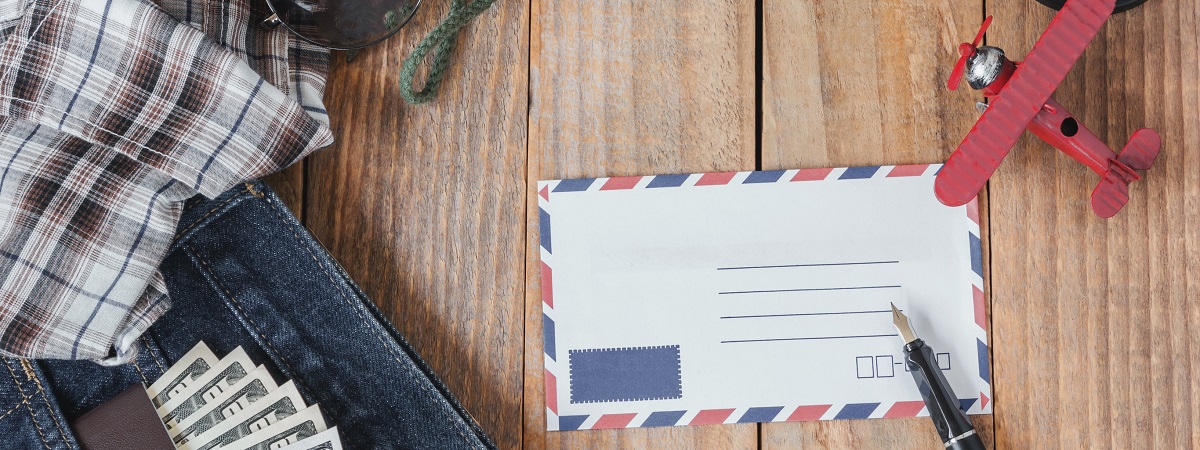
I’ve now been asked several times whether flying with fountain pens poses a problem. Is it safe? Could they explode in your pocket? Is it even legal? Well, let’s bust the myths.
Now that COVID restrictions have been eased, many people are ramping up their travel plans again, heading for the open road and sky.
I have a couple of trips on my own calendar already, and I don’t ever leave my analog life behind or take a break from writing. On the contrary, when I travel for work I am often at conferences and meetings where I need to take notes. And when the trip is for pleasure, I love to journal about the places I visit. Sure, I could pack my laptop, but where’s the joy in that? Rest assured, I’ll be flying with fountain pens, notebooks and accessories.
Writing on the road is not a new problem. The famous English author Charles Dickens started out his career as a journalist and always carried his “traveling inkpot” — an ingenious little invention that kept spills and leaks to a minimum in the days of much bumpier rides. Admittedly, though, Mr. Dickens never had to get on an airplane …
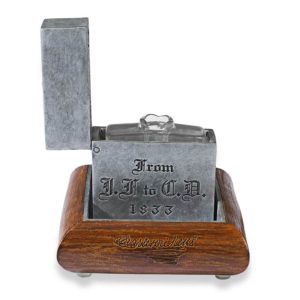
Table of Contents
Flying With Fountain Pens: The Concerns
Honestly, the fears about fountain pens on planes are mostly way overblown. There are, however, some things that you should be aware of. Here are the facts:
The main concern people have is that a pen might leak or spurt its ink because of the decrease in air pressure as you gain altitude. As the pressure drops in the aircraft cabin, any air inside the sealed barrel of your fountain pen will still be at the level of pressure it was at on the ground. This air will want to equalize with the surrounding cabin pressure and its only “way out” is through the nib. Therefore, any ink that is between the escaping air and the nib may be forced out as well.
Note that this is only a potential issue during take-off, and the reality is that the pressurized cabins of today’s aircraft are very efficient at maintaining constant pressure levels for the comfort of passengers.
Nevertheless, here are a few basic precautions you can consider before boarding to avoid any problem:
- Remove all the air from the barrel of your fountain pen. If your pen has a cartridge converter, you can do this simply by giving the knob a few clockwise turns to force ink down into the feed and any air out through the nib.
- Alternatively, fill your pen up with ink to its maximum capacity. Then there won’t be room for any air inside the pen.
- Carry your pen with the nib always pointing upwards. This ensures that the ink level will be below any air escaping through the nib.
- If you’re still uber worried … simply clean your pen out before you travel. In other words, fly with an empty fountain pen and then fill it up when you arrive at your destination.
My Own Simple Solution for Traveling with Fountain Pens
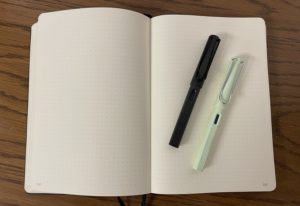
I have a couple of LAMY Safaris that are my go-to travel fountain pens, and for good reasons: (1) they are wonderfully reliable writers, (2) they stand up well to being thrown about or dropped, and (3) they are an inexpensive option, so I wouldn’t be devastated if I should ever lose one on the road.
And here’s my travel strategy — I keep these Safaris for use only with disposable ink cartridges. Every other fountain pen I own is either a piston-filler (my personal preference), or I’ve fitted them with a cartridge converter. But the convenience of the disposable type is just so handy in certain situations, including flying.
It means I can carry several brand new, sealed ink cartridges in my carry-on, or even in a pocket, perfectly safely. The quantity of ink in each cartridge is well under the amount of liquid permitted in a container by TSA. So, I can keep my Safaris empty until I get to my destination, but then just click in a cartridge and I’m ready to go. If I ever have to write on a plane, I always have a mechanical pencil with me, because that’s all I ever use to write in my daily planner which goes with me everywhere.
Now, my disposable cartridge solution may not appeal to everyone, so you may want to travel with ink bottles. To each their own.
Traveling With Ink Bottles
This does not need to present a huge problem, as long as you follow a few basic rules …
- If you want to fly with ink bottles in your carry-on, make sure that the liquid capacity of each bottle is under the quantity permitted by TSA. Otherwise you risk having to throw them out on your way through airport security. You will need to place larger bottles in your checked luggage.
- Screw all lids on tight to seal them properly, and then place them inside a zip-lock bag. The biggest concern is not that a glass bottle will leak, but that it might break. (Airline baggage handlers aren’t always the gentlest!) So, wrap your ink bottle in tissue paper or a rag before placing it in the plastic bag.
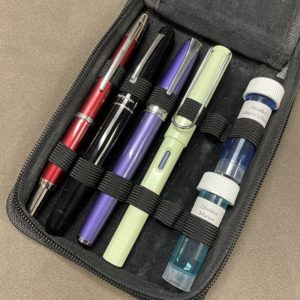 Alternatively, here’s another idea. Use plastic 2ml sample vials instead of whole bottles. Just fill up as many as you need — they are cheap, harder to break, and super easy to slip into the bands in a pen case. (See picture).
Alternatively, here’s another idea. Use plastic 2ml sample vials instead of whole bottles. Just fill up as many as you need — they are cheap, harder to break, and super easy to slip into the bands in a pen case. (See picture).
So, hopefully I’ve covered all of the major questions about flying with fountain pens and ink. Finally, just a word about paper.
Writing Paper for Your Travels
I tend to limit myself to a commonplace book or a dedicated travel journal. Loose leaf paper and notepads (especially the spiral-bound kind) don’t tend to travel quite as well. Get a bound book.
One very popular choice for travel journals is the Midori range of Traveler’s Notebooks. (The company has now rebranded under the name “The Traveler’s Company” instead of Midori.)
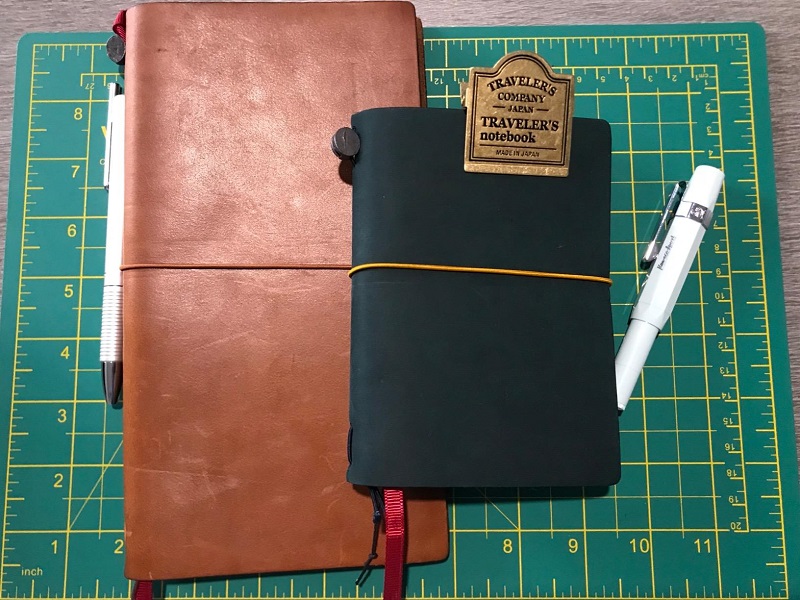
They consist of a beautiful soft leather binder that holds a number of different inserts which you purchase separately and can “mix and match”. The thin “MD” paper is remarkably fountain pen friendly, and the quality leather softens and patinas beautifully with age and use.
Traveler’s Notebooks come in Regular (4.9 x 8.7 inches) and Passport (3.9 x 5.3 inches), each in a range of four classic colors. When I first saw them, I thought the Regular seemed the obvious choice, and that the Passport size just looked too small to be of a lot of use. I have since changed my mind. The Standard will still appeal to many, but when filled with refills it does get bulky. The Passport size, however — even when fully loaded — slips into a pocket, so it can go everywhere with you (which is the point). I love mine. (Read my full review).
What issues have you had traveling with pens, inks and stationery? Any other tips for us? Leave a comment.
Good morning/afternoon/evening,
I happened across your site sometime early last year, I believe it was. I thoroughly enjoyed the articles I read. I “converted” to fountain pens in theory November of 2020, in practical application January of 2021. I too am a pastor, and I write the first draft of my sermon notes by hand. Same with my book manuscripts. I did my (probably) last flying long before I went down the fountain pen rabbit hole, but I have read many folks expressing their fears of flying with them.
Hi David, thanks for your encouraging words. I’m so glad you’ve found some value in the site. That’s a deep rabbit hole 😊, but it’s given me a lot of enjoyment.
I hope we’ll get to hear more about how you incorporate these things in ministry!
Grace to you and yours, Phil.
Thank you for the quick reply. I seem to have a fountain pen “convert” in my congregation. I had a pen I wasn’t as impressed with as I thought I’d be, so I offered it to a young man in the church (I had let him use my Pilot Metropolitan on one occasion, with bated breath; I needn’t have worried). He loved it. A little while later I was going thru my pens and came across three I didn’t want because they laid too broad a line (I prefer an Eastern F or EF). I gave that same young man two of them, and one of our ladies one. Haven’t heard anything from her on how she likes it, but he is never without one at church now.
I had a similar experience this week too, David. Our Youth Pastor asked me about my pens, so I gave him a LAMY Safari to try. He appears hooked, and now is talking about copying the Scriptures. (I hope his wife will still talk to me if he starts to really get into pens!)